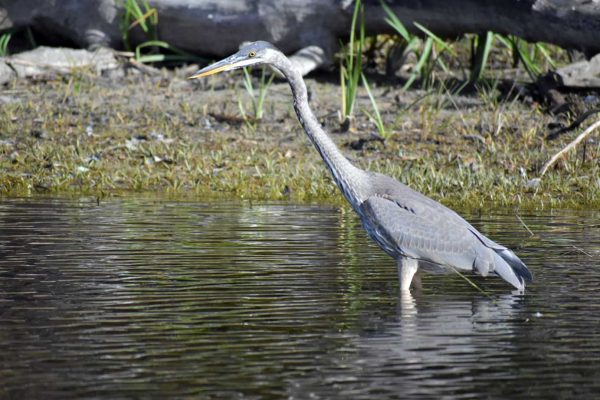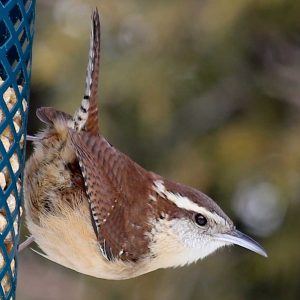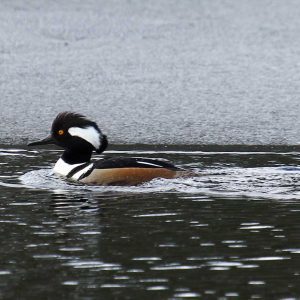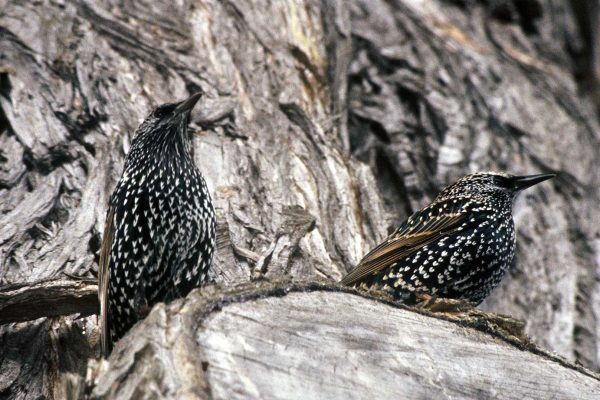
The authors had never seen a Great Blue Heron on the Augusta area Christmas Bird Count in the 18 years that they have participating in it—until this year. (photo by Beth Comeau)
The mild temps on Saturday, December 16, had us wondering: is this really the Christmas Bird Count time of year? (It felt a little like Breeding Bird Atlas time!) But indeed, there we were, traipsing through the streets of our Gardiner neighborhood and beyond, binoculars around our necks, as part of the Augusta area Christmas Bird Count. The warm day was, sadly, one in a series of rather mild days that increasingly have become the new normal as climate change impacts us all.
Our bird list for the day, in places, reflected the mild weather. We saw a lingering Great Blue Heron along the Kennebec River in Gardiner. In some years past, the river would be largely frozen on the day of the Christmas Bird Count, making it highly unlikely that this species would be present. Instead, this was the first time we’d seen one on the count in the 18 or 19 years that we’ve been participating.

Caroline Wrens have become more common in Maine with warming temperatures. The authors saw three during the recent Christmas Bird Count excursion. (photo by David Small)
Other sightings were more reflective of successes on the environmental front, like the 20 Bald Eagles soaring around in a single view as we scoped across the river to the Randolph side. Such a sight would not have been possible without the banning of DDT decades ago. Eagle populations and other species have also been given a boost thanks to removal of the Edwards Dam in Augusta—work led by the tireless efforts of the Natural Resources Council of Maine and our Kennebec Coalition partners in 1999.
We tallied at least three Carolina Wrens, which have become more common in Maine with increasingly warming temperatures. The Eastern Bluebird we saw near the local cemetery, however, may have stuck around regardless, being what we birders like to call a “half-hardy.” Cobbosseecontee Stream, from our observations having lived in Gardiner for the last 18 years, doesn’t freeze much, so those Hooded Mergansers, like the bluebird, stood a good chance of being around regardless.

Hooded Mergansers were spotted bobbing about in Cobbosseecontee Stream in Gardiner during the count. (photo by David Small)
The sighting that enthralled us the most was not any of these, however, and the species involved was not an unusual one. It was an event that we have tried unsuccessfully to document for the Augusta Christmas Bird Count for all the many years that we have been a part of it.
Every now and then over the years, we have driven in winter over the bridge that spans the Kennebec River between Gardiner and Randolph right around sunset when we’d suddenly spy a large number of black birds sweeping in under the bridge. They were European Starlings, we knew, but how many exactly? And were there any other species mixed in—perhaps a Brown-headed Cowbird, Red-winged Blackbird, or Common Grackle—among them? Knowing that some number of starlings fly in to spend the night under this bridge, we have wanted to be there at the right time during the Christmas Bird Count to tally them.
But somehow, we never had been in the right spot at the right time.

European Starlings often fly in what are called “murmurations,” which the authors were finally able to witness live and in person recently. (USFWS)
This year, we thought we had missed it once again despite standing, from about 15 minutes before sunset, on the beautiful platform on the Gardiner waterfront that overlooks the river and the bridge. We had waited and waited as the pink ebbed from the darkening sky. Finally, just as we were starting to walk away, we spotted something in the sky coming from the West. A high-flying, tight flock of dark birds—about 300 of them! Through our binoculars we could see that they were indeed starlings.
The flock stayed hundreds of feet above the river and swirled round and round in perfect unison, changing shape, like a dancer in the sky. Sometimes the flock looked like a perfect ball; seconds later it became an oval and then compressed into a wide, swooping belt. Then the entire flock would turn and coalesce once more into a ball, then shift yet again so that the ball changed from light to dark.
This was the famous murmuration movement of starling flocks that periodically goes viral on the internet when these spellbinding movements are captured on video by some lucky observer.
We were the lucky ones this time, and we watched in awe for about 10 minutes as the flock slowly descended closer and closer to the bridge. At nine minutes after sunset, in some miraculous and mysterious way, 300 birds poured in under the bridge as one and disappeared in mere seconds, tucked in safely and warmly for the night.
What a sight!
—Allison & Jeff Wells











Thank you so much for sharing!!! What a magical sight to see the starlings putting on such a wonderful display.
Thank you for taking the time to read and comment on our blog, Linda. Happy New Year!
Allison & Jeff
Thanks so much for your detailed account. We were away this year so I missed out on the count. The murmuration sounded magical.